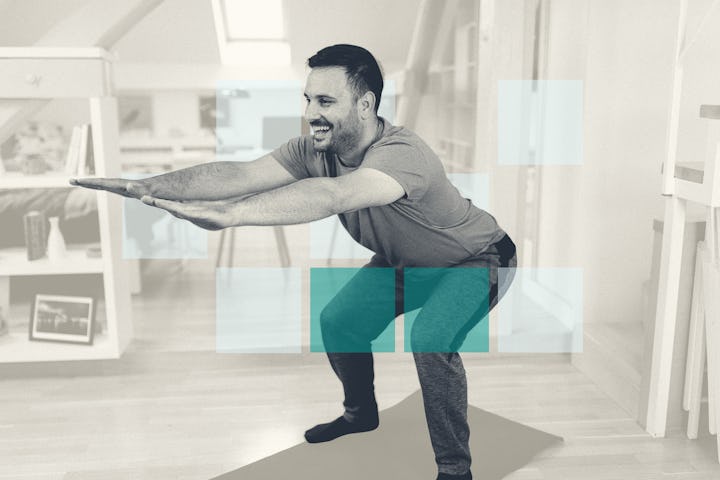The Only 6 Moves You Need To Get Back In Shape
There's nothing more difficult than getting fitness back. But it can be done. Here's your game plan.

If it’s been a while since you last worked out, you’re not alone. The pandemic has forced us all to work out in our living rooms — or not at all. So how do you get back in the swing of things? If you took a (long) break from your workout routine, it’s probably going to take some time and commitment to get back to your previous fighting shape. But it can be done.
The key is to ease back into it. That’s the advice of Ryan Charles Stec, a Certified Functional Strength Coach and Pain-free Performance Specialist who owns True Grit Strength gym in Austin, Texas. “Easing into it can be hard when you haven’t worked out in a while and now you have the motivation to work out every single day,” he says. “But that can lead to injury and burnout.” Stec recommends starting with two to three strength training sessions a week and listening to your body before adding more.
How can you tell if you’re doing too much? “The 1-10 pain scale is a common tool to use,” Stec says. “If you’re generally healthy and you feel sharp pain at level of 6 or more during your workout, that’s acute.” It’s a red flag that you’re pushing too hard, too quickly.
Even with all the motivation in the world, getting back into a regular routine can take more than just lacing up your sneakers and jumping in. “The trifecta of good nutrition habits, regular exercise, and proper sleep and stress management will make an important positive impact on your health, but don’t tackle everything at once,” says Stec. “Start with having a set time to work out, and keep it consistent.”
In other words? It might take a few months to get back into shape. Be patient, keep at it, and focus on these six foundational movements to ease back into the swing of things.
Bodyweight Squats
With feet roughly hip-width apart, squat down under control and return to start position. Make sure your chest stays up and knees press out for the entire squat. You can turn your toes out and adjust your stance to what is most comfortable for you. If this gets too easy, don’t speed up — instead, grab a medicine ball or put a kid on your back and carry that weight.
Goblet Squats
Begin with a dumbbell or kettlebell in the goblet position (held at chest). With feet roughly hip-width apart, squat down under control and return to start position. Make sure your chest stays up and knees press out for the entire squat. You can turn your toes out and adjust your stance to what is most comfortable for you.
Home Workout Variation: Load up a backpack full of heavy books and bear hug it in front of you for added resistance.
Push-Ups
Begin in a high plank position (on hands) with a straight line from your shoulders, hips, and knees. You want to form an “A” shape with your elbows, not a “T” (elbows flared out) or an “I” (elbows tucked in). Create full-body tension, like you would for a plank, and lower your chest to the floor and return to the starting position.
Split Squats
Begin in a half-kneeling position with your right knee touching the floor and your left foot out in front of you. Your right knee should be directly under your right hip and your left heel directly below your left knee. Stand up, driving your left heel into the ground, and slowly lower back to the starting position.
Home Workout Variation: Load up a backpack full of heavy books and bear hug it in front of you for added resistance.
Hand-Supported Dumbbell Rows
Begin in an athletic position with knees slightly bent and hips back like you’re reaching to pick something off the floor. With the dumbbell in one hand, place the opposite hand on a chair or weight bench, maintaining a flat back. Row the dumbbell towards your hip, pulling your elbow towards your back pocket. Return slowly to a starting position.
Home Workout Variation: A loaded backpack or duffel bag works well here as well.
Dumbbell Romanian Deadlift
Begin standing with soft knees and weights at your thighs. Maintaining a flat back (shoulders pushed down and back), sit your hips back and down until the weights reach just below your knee or until you feel a solid stretch in your hamstrings. Keep your core braced as you return to a starting position.
Home Workout Variation: Loaded backpack or duffel bag works well here as well. You can also replace this movement with a glute bridge on the floor.
This article was originally published on